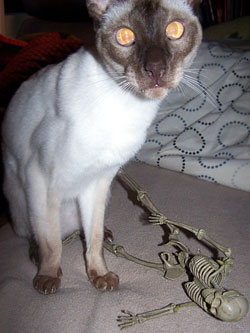Underweight Cat Worries
 I haven’t posted for a while. My sister had serious surgery, and I’ve been worried about Minkey. You see, he’s been dropping weight until he went from slightly underweight cat to positively skeletal.
I haven’t posted for a while. My sister had serious surgery, and I’ve been worried about Minkey. You see, he’s been dropping weight until he went from slightly underweight cat to positively skeletal.
Gaunt, even.
I did all the right things. I had him checked, and all the results showed no problems. I’m already fanatical about providing him with fresh water, several times a day. And his coat passes the “pinch” test for dehydration with flying colors.
“He’s just an older cat,” shrugged the vet.
But Minkey’s only fourteen. Should he really be dropping weight like that?
He seems happy and healthy. He plays just as much as ever (if not more!) And he gobbles down his special premium Royal Canin Siamese cat food with just as much gusto.
Okay, so he eats only hard “kibble”, which was supposed to be the best for your cat and his teeth back when I first checked into Siamese diets – but which there’s evidence now to show may actually not be ideal. So mindful of the vet’s instructions, I tried to add premium, top-of-the-line, expensive, soft cat food. With good, non-toxic ingredients. (I did a lot of research.)
Minkey hated them, every one. He’d check out his bowl, glare at me, “cover it up” and stalk away, fangs bared in a rictus of distaste. (He’s repeated that with every brand, so far!)
“Older cat food” is no solution either – mostly, that’s for kidney problems (which Minkey apparently doesn’t have) or to help cats lose weight – not gain it.
And for the first time in years, he’s actually stopped bazooka-barfing, this year. He used to regularly upchuck all his meals, until we discovered Royal Canin, which is designed specifically to help Siamese cats not inhale their food, but chew it properly. (It worked – and Minkey’s been eating 3 times as much as usual all year!)
Finally, I noticed his favorite toy of the moment – Mr. Skeleton, a leftover Hallowe’en toy. Hmmm… all bones. Perhaps Minkey is anorexic? Trying to imitate his hero? Influenced by Hollywood? Batting Mr. Skeleton around too much and racing round the house far more than usual?
Cat ADHD?
Seriously, if anyone has any ideas about what could be wrong with a severely underweight cat who behaves as if he’s on cat-amphetamines, please post a comment! At this point, I’ll check out anything.
It’s sad to think my immortal playmate Minkey might actually be into older cat health issues now.





You should have the vet check Minkey’s t4 levels to see if he has hyperthroidsim. My 14 year old Siamese Lil’ Kat was just diagnosed with hyperthyroidism. It made sense after dealing with months of her verocious appetite and her non stop asking for food. Good Luck to you and Minkey. (By the way, Lil’ Kat’s favorite toy is a little toy jack o lantern that was bought after Halloween on clearance. What is it with the Siamese cats and Halloween toys?)
That’s a great point, Laurel. I’ll phone the vet and ask if this was done specifically. Li’l Kat and Minkey are just about the same age, too.
As for the Halloween toys – I think it’s their Dark Side, LOL. (Either that, or the bones are nice and Rattly!) 😉
I concur. The symptoms sound a lot like my cat’s when her hyperthyroid got really active. Best of luck!
Thanks, Ishtar. My vet and I are keeping an extra close eye on his thyroid – and I really appreciate you and Laurel taking the time to tip me off about this issue.
I’m Schrodinger, a four-year-old Tonkinese who hangs out at a vet clinic just for cats.
It’s good that you’re following up with the thyroid stuff. They see quite a few “over-10” cats with thyroid issues here.
The vet clinic where I hang out uses a thyroid test called T4 by Equilibrium Dialysis (T4ED). It’s more sensitive and precise in cats than the standard “Free T4”, which is actually more accurate in detecting HYPOthyroidism. HYPOthyroidism is more common in dogs, though it can occur in cats during treatment or following the removal of the thyroid gland.
This test is a bit more expensive and it takes a few days longer (and must be done at an outside laboratory), but it has been the key to diagnosing many hyper-T kitties when the regular test was normal or only slightly high. Without getting too technical, there are some medical conditions that can cause a regular T4 test to “look normal” when in fact the thyroid is high.
Hope that helps you and your vet to get a good solid answer to what’s going on with your Meezer.
Now if you’ll excuse me, there’s a shiny object over here that needs my attention. Good luck!
-Schrodinger the Tonkinese, as told to his typist and vet-tech Mom who takes the little guy home every night.
Minkey thanks you for writing, Schrodinger. His thyroid test was indeed normal – but we did not know about the T4ED then. I’m sure it was the “standard” one.
I don’t know if we can get the T4ED here in Canada, but you can be sure we’ll ask our vet! This is great info for other readers who own Siameasles, too. That’s what I love about the Meezer community. 🙂
Thanks for visiting us. And, uh, thank your Mom for doing the typing (tell her I said you sound like a cutie.) 😉